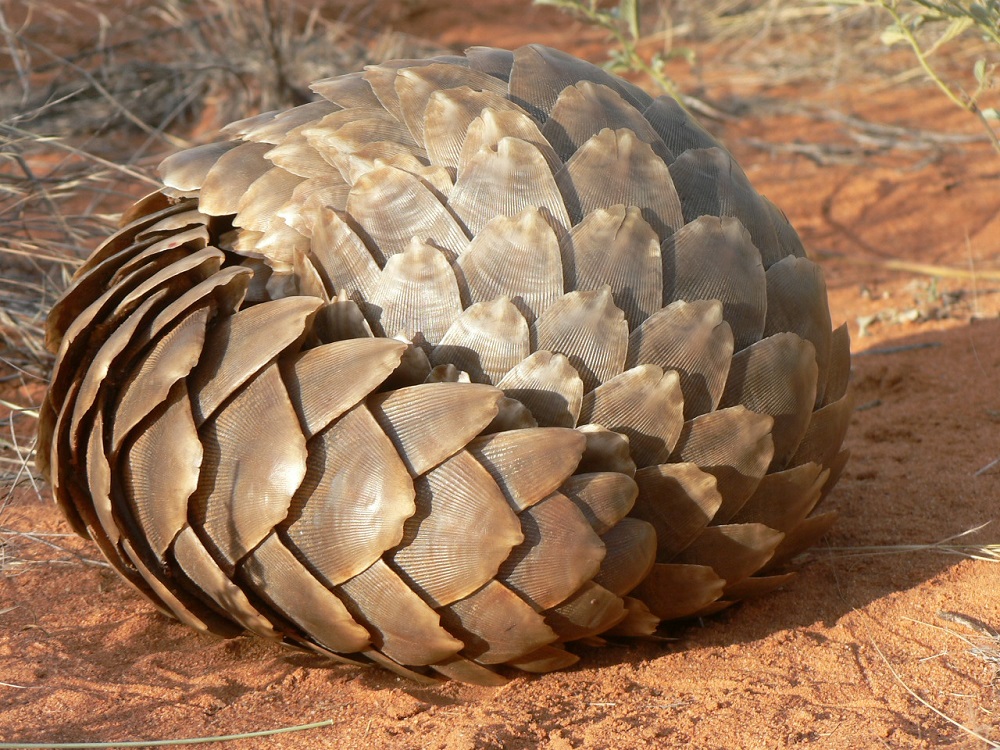Africa is a vast continent of many extremes and great diversity, and is home to four species of pangolins. Two species (the White-bellied pangolins, Phataginus tricuspis and Black-bellied Pangolin Phataginus tetradactyla) are small, arboreal species (generally weighing less than 3 kg) that inhabit tropical rain forests and swamp forests in Central and West Africa. The remaining two species (Temminck’s Ground Pangolin and Giant Ground Pangolin) are terrestrial and can weigh as much as 19 kg and 30 kg, respectively. Temminck’s Ground Pangolin occurs in savannahs in southern and East Africa, while the Giant Ground Pangolin occupies forests and forest-savannah mosaics in Central and West Africa.
Due to their secretive nature, low population densities and predominantly nocturnal habits, pangolins have not enjoyed nearly as much research attention as many of the larger and more charismatic species. This is changing though, and through the actions of both the African Pangolin Working Group and the IUCN Species Survival Commission Pangolin Specialist Group pangolins are starting to receive the attention that they deserve, and sorely require.
To date most research on the African pangolin species has focussed on Temminck’s Ground Pangolin, predominantly because most research has occurred in southern Africa where only this species occurs, but also due to logistical reasons. However, this situation is changing, with an increasing amount of research being focussed on the other three African species. The lessons that were learnt and the equipment that was designed and tested during the studies on Temminck’s Ground Pangolin will enable us to undertake valuable research on the remaining three African species, for which even the most basic of ecological traits remain virtually unknown.
In addition to ecological studies, recent research has focussed on quantifying the levels of trade in all four African pangolin species, to allow us to better predict the impact that this trade is having. Students under our auspices have also recently finished mapping the entire mitochondrial genome of Temminck’s Ground Pangolin, and are busy mapping the mitochondrial genomes of the White-bellied Tree Pangolin and Giant Ground Pangolin (the Black-bellied Tree Pangolin’s genome has been sequenced previously). This research has and will lay the foundation for future genetic studies on these four species, including understanding the relationship between the species as well as the origin of pangolins in Africa. This data has already been used to investigate whether there are genetic differences between different Temminck’s Ground Pangolin populations in southern Africa. The results of this study have helped to guide decisions on how to manage these populations as well as how to manage confiscated pangolins. Together with the Tikki Hywood Trust in Zimbabwe a successful rehabilitation and release program has been formulated, and all animals are closely monitored after they have been released. This has helped us to verify that rehabilitation is indeed possible, and greatly assists when it comes to dealing with confiscated pangolins. We have also updated the regional Red List Assessment for Temminck’s Ground Pangolin in South Africa, as well as the IUCN Red List status of all four African pangolin species (both to be released later this year). Furthermore, we have undertaken a review of the main threats facing Temminck’s Ground Pangolin, principally poaching and electric fences, and are working to address them.
The key to global pangolin conservation is awareness: both public awareness and creating awareness among law enforcement officials. Both the IUCN SSC Pangolin SG and the African Pangolin Working Group have active media campaigns to raise public awareness. In addition, the APWG and our partner, the Tikki Hywood Trust, are actively engaging with government and law enforcement officials across African range states to raise awareness about the plight of pangolins, what the relevant laws are in each country, and what can be done to improve the current situation. It is hoped that through these close working relationships pangolins will be afforded better protection and the current, high rate of poaching will be reduced.
We are at the start of a very exciting time for pangolin research and conservation in Africa as well as globally, and it couldn’t have come sooner. Worldwide, pangolins are facing a multitude of threats and are probably the most traded group of animals at present. A lot has already been achieved, but a lot still remains to be done. Through the actions of the IUCN SSC Pangolin Specialist Group and the APWG, together with our partners, pangolins will have a fighting chance at a future and perhaps one day our descendants will also experience the joy and thrill of chancing upon one of these unique and secretive animals in the wild.
by Darren Pietersen, Africa Vice-Chair, IUCN SSC Pangolin Specialist Group and Chair of the African Pangolin Working Group.
Top image on this post, copyright, Darren Pietersen.





